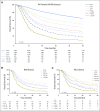Metastatic Lymph Node Burden and Survival in Oral Cavity Cancer
- PMID: 28880746
- PMCID: PMC5791830
- DOI: 10.1200/JCO.2016.71.1176
Metastatic Lymph Node Burden and Survival in Oral Cavity Cancer
Abstract
Purpose Current staging systems for oral cavity cancers incorporate lymph node (LN) size and laterality, but place less weight on the total number of positive metastatic nodes. We investigated the independent impact of numerical metastatic LN burden on survival. Methods Adult patients with oral cavity squamous cell carcinoma undergoing upfront surgical resection for curative intent were identified in the National Cancer Data Base between 2004 and 2013. A neck dissection of a minimum of 10 LNs was required. Multivariable models were constructed to assess the association between the number of metastatic LNs and survival, adjusting for factors such as nodal size, laterality, extranodal extension, margin status, and adjuvant treatment. Results Overall, 14,554 patients met inclusion criteria (7,906 N0 patients; 6,648 node-positive patients). Mortality risk escalated continuously with increasing number of metastatic nodes without plateau, with the effect most pronounced with up to four LNs (HR, 1.34; 95% CI, 1.29 to 1.39; P < .001). Extranodal extension (HR, 1.41; 95% CI, 1.20 to 1.65; P < .001) and lower neck involvement (HR, 1.16; 95% CI, 1.06 to 1.27; P < .001) also predicted increased mortality. Increasing number of nodes examined was associated with improved survival, plateauing at 35 LNs (HR, 0.98; 95% CI, 0.98 to 0.99; P < .001). In multivariable models accounting for the number of metastatic nodes, contralateral LN involvement (N2c status) and LN size were not associated with mortality. A novel nodal staging system derived by recursive partitioning analysis exhibited greater concordance than the American Joint Committee on Cancer (8th edition) system. Conclusion The number of metastatic nodes is a critical predictor of oral cavity cancer mortality, eclipsing other features such as LN size and contralaterality in prognostic value. More robust incorporation of numerical metastatic LN burden may augment staging and better inform adjuvant treatment decisions.
Figures






References
-
- Cerezo L, Millán I, Torre A, et al. : Prognostic factors for survival and tumor control in cervical lymph node metastases from head and neck cancer. A multivariate study of 492 cases. Cancer 69:1224-1234, 1992 - PubMed
-
- Amin MB, Edge S, Greene F, et al (eds): AJCC Cancer Staging Manual (ed 8). New York, NY, Springer, 2017.
-
- Roberts TJ, Colevas AD, Hara W, et al. : Number of positive nodes is superior to the lymph node ratio and American Joint Committee on Cancer N staging for the prognosis of surgically treated head and neck squamous cell carcinomas. Cancer 122:1388-1397, 2016 - PubMed
-
- Divi V, Harris J, Harari PM, et al: Establishing quality indicators for neck dissection: Correlating the number of lymph nodes with oncologic outcomes (NRG Oncology RTOG 9501 and RTOG 0234). Cancer 10.1002/cncr.30204 [epub ahead of print on July 15, 2016] - DOI - PMC - PubMed
-
- Divi V, Chen MM, Nussenbaum B, et al: Lymph node count from neck dissection predicts mortality in head and neck cancer. J Clin Oncol 34:3892-3897, 2016. - PubMed
MeSH terms
Grants and funding
LinkOut - more resources
Full Text Sources
Other Literature Sources
Medical
Miscellaneous

